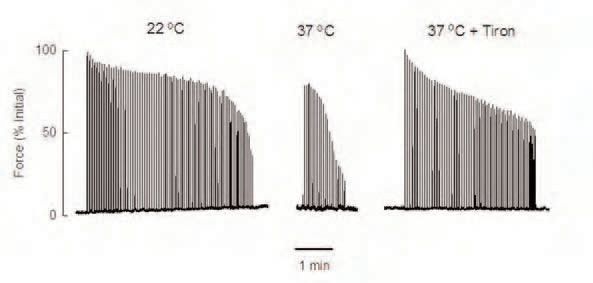
Physiology News Magazine
How to perform well in the heat
Features
How to perform well in the heat
Features
David G Allen & Terence R Moopanar
Institute for Biomedical Science and School of Medical Sciences, University of Sydney, Australia
https://doi.org/10.36866/pn.60.28

Athletes are aware that as the ambient temperature rises it becomes harder to perform at their peak. Mostly this is because of the problems of temperature control, fluid balance and the competition between skin and muscles for blood flow. But it is also known that, as muscles get hotter, their performance can deteriorate and they fatigue more rapidly. As an athlete one wants to know the best way to minimize the effects of heat if one is forced to compete on a really hot day; as physiologists we would like to know the mechanisms whereby increased temperature affects the performance of muscles. Our recently published paper suggests answers to both these questions (Moopanar & Allen, 2005).
Our laboratory studies the intracellular mechanisms involved in muscle fatigue. We use single fibres dissected from mouse muscles which allow us to simultaneously measure force and intracellular ions and to investigate fatigue mechanisms. A number of different mechanisms of fatigue have been identified and obviously we would like to concentrate on those mechanisms that are important to normal individuals going about their daily life or to athletes pushing the boundaries of physical performance. For instance, the popular hypothesis that accumulation of intracellular lactic acid is a major cause of fatigue does not seem to be the case in mammalian muscles (Westerblad et al. 2002). In a recent Physiology News article we summarized current ideas about the most important mechanisms limiting muscle performance for various activities (Allen et al. 2003).
Until a few years ago all our experiments on isolated single fibres were performed at room temperature. We did this for two reasons; one was the trivial one that it is simpler to work at room temperature. The second reason was more fundamental – that isolated single muscle fibres stop contracting after a short time at 37°C, making long experiments impossible. Recently we decided to try again to work at 37°C, since evidence was accumulating that fatigue at room temperature involved different mechanisms from those at body temperature.
When we heated our single fibres up to 37o C, we confirmed that they soon stopped contracting and when we fatigued them with repeated tetani the force declined substantially faster than at 22°C (Fig. 1). However we were aware that our colleague Mike Reid in Texas had shown that in respiratory muscles accumulation of reactive oxygen species (ROS) occurred during repeated contractions and seemed to contribute to fatigue (Reid et al. 1992). We therefore added a membrane-permeant ROS scavenger (Tiron) to our solutions and found, to our delight, that the muscles now survived much better at 37°C and fatigued at the same rate as at 22°C (Fig. 1).

The great advantage of the single fibre preparation is that we were able to establish the mechanism whereby force declines more rapidly at 37°C. It turns out that the calcium sensitivity of the contractile machinery declines very rapidly when muscles are stimulated at 37°C. ROS frequently convert free sulphydryl groups to disulphide bridges thereby changing protein properties. So our working hypothesis is that a protein which regulates calcium sensitivity undergoes this type of change.
These experiments suggest that, if you want to minimize muscle fatigue at high temperatures, you might try to improve your ROS scavenging capability either by dietary methods (lots of Vitamin C and E) or by a training protocol which induced endogenous ROS scavengers. Unfortunately, current evidence on whether these strategies work or not is inconclusive (Jackson et al. 2004).
An unresolved puzzle is why isolated single fibres survive so poorly and are more susceptible to fatigue at 37° C. Obviously our own intact muscles work pretty well at 37°C and muscles have developed methods of scavenging ROS so that most of the time the levels of ROS are close to those which produce optimum performance. This suggests that in an isolated single fibre there is excessive endogenous ROS production and/or some of the endogenous scavenging pathways are impaired. These are areas we would like to explore in the future; together with identifying the target protein(s) and how they are modified by ROS.
References
Allen DG, Lännergren J & Westerblad H (2003). Limits to human performance caused by muscle fatigue. Physiology News 53, 7-10.
Jackson MJ, Khassaf M, Vasilaki A, McArdle F & McArdle A (2004). Vitamin e and the oxidative stress of exercise. Ann N Y Acad Sci 1031, 158-168.
Moopanar TR & Allen DG (2005). Reactive oxygen species reduce myofibrillar Ca2+-sensitivity in fatiguing mouse skeletal muscle at 37 oC. J Physiol 564, 189-199.
Reid MR, Haack KE, Franchek KM, Valberg PA, Kobzik L & West MS (1992). Reactive oxygen in skeletal muscle I. Intracellular oxidant kinetics and fatigue in vitro. J App Physiol 73, 1797-1804.
Westerblad H, Allen DG & Lannergren J (2002). Muscle fatigue: lactic acid or inorganic phosphate the major cause? News Physiol Sci 17, 17-21.
